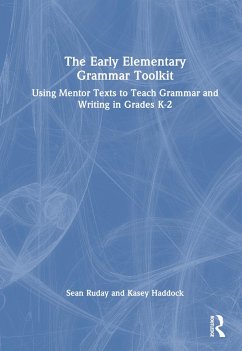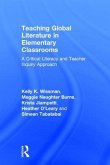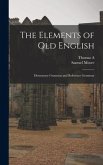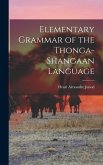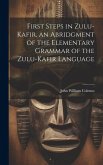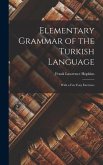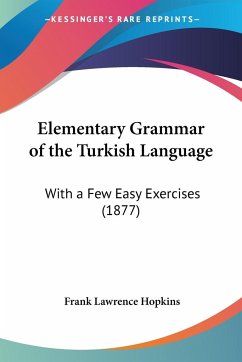Sean Ruday, Kasey Haddock
The Early Elementary Grammar Toolkit
Using Mentor Texts to Teach Grammar and Writing in Grades K-2
Sean Ruday, Kasey Haddock
The Early Elementary Grammar Toolkit
Using Mentor Texts to Teach Grammar and Writing in Grades K-2
- Gebundenes Buch
- Merkliste
- Auf die Merkliste
- Bewerten Bewerten
- Teilen
- Produkt teilen
- Produkterinnerung
- Produkterinnerung
Teaching grammar can be overwhelming and is often an overlooked part of effective instruction, especially for young learners. The Early Elementary Grammar Toolkit to the rescue! This comprehensive guide makes grammar instruction in the K-2 classroom fun and meaningful.
Andere Kunden interessierten sich auch für
![Teaching Global Literature in Elementary Classrooms Teaching Global Literature in Elementary Classrooms]() Kelly K. WissmanTeaching Global Literature in Elementary Classrooms176,99 €
Kelly K. WissmanTeaching Global Literature in Elementary Classrooms176,99 €![The Elements of Old English; Elementary Grammar and Reference Grammar The Elements of Old English; Elementary Grammar and Reference Grammar]() Samuel MooreThe Elements of Old English; Elementary Grammar and Reference Grammar30,99 €
Samuel MooreThe Elements of Old English; Elementary Grammar and Reference Grammar30,99 €![Elementary Grammar of the Thonga-Shangaan Language Elementary Grammar of the Thonga-Shangaan Language]() Henri Alexandre JunodElementary Grammar of the Thonga-Shangaan Language29,99 €
Henri Alexandre JunodElementary Grammar of the Thonga-Shangaan Language29,99 €![First Steps in Zulu-Kafir, an Abridgment of the Elementary Grammar of the Zulu-Kafir Language First Steps in Zulu-Kafir, an Abridgment of the Elementary Grammar of the Zulu-Kafir Language]() John William ColensoFirst Steps in Zulu-Kafir, an Abridgment of the Elementary Grammar of the Zulu-Kafir Language28,99 €
John William ColensoFirst Steps in Zulu-Kafir, an Abridgment of the Elementary Grammar of the Zulu-Kafir Language28,99 €![Elementary Grammar of the Turkish Language Elementary Grammar of the Turkish Language]() Frank Lawrence HopkinsElementary Grammar of the Turkish Language29,99 €
Frank Lawrence HopkinsElementary Grammar of the Turkish Language29,99 €![Elementary Grammar of the Turkish Language Elementary Grammar of the Turkish Language]() Frank Lawrence HopkinsElementary Grammar of the Turkish Language18,99 €
Frank Lawrence HopkinsElementary Grammar of the Turkish Language18,99 €![The 3 M's of Writing Your Book Toolkit The 3 M's of Writing Your Book Toolkit]() Lynnecia S. EleyThe 3 M's of Writing Your Book Toolkit19,99 €
Lynnecia S. EleyThe 3 M's of Writing Your Book Toolkit19,99 €-
-
-
Teaching grammar can be overwhelming and is often an overlooked part of effective instruction, especially for young learners. The Early Elementary Grammar Toolkit to the rescue! This comprehensive guide makes grammar instruction in the K-2 classroom fun and meaningful.
Produktdetails
- Produktdetails
- Verlag: Routledge
- Seitenzahl: 196
- Erscheinungstermin: 1. März 2023
- Englisch
- Abmessung: 260mm x 183mm x 15mm
- Gewicht: 574g
- ISBN-13: 9781032298184
- ISBN-10: 1032298189
- Artikelnr.: 66695733
- Herstellerkennzeichnung
- Libri GmbH
- Europaallee 1
- 36244 Bad Hersfeld
- gpsr@libri.de
- Verlag: Routledge
- Seitenzahl: 196
- Erscheinungstermin: 1. März 2023
- Englisch
- Abmessung: 260mm x 183mm x 15mm
- Gewicht: 574g
- ISBN-13: 9781032298184
- ISBN-10: 1032298189
- Artikelnr.: 66695733
- Herstellerkennzeichnung
- Libri GmbH
- Europaallee 1
- 36244 Bad Hersfeld
- gpsr@libri.de
Sean Ruday is an associate professor of English education at Longwood University and a former classroom teacher. He frequently writes and presents on innovative ways to improve students' literacy learning. You can follow him on Twitter at @SeanRuday and visit his website at www.seanruday.weebly.com. Kasey Haddock is a kindergarten teacher in Virginia. She has a true passion for shaping and molding the minds of future generations and laying the early foundations of students' education. You can follow her on Twitter at @haddock_kasey.
Meet the Authors
Acknowledgments
Support Material
Introduction: Using Mentor Texts to Unlock the Tools of Grammar and Writing
With Young Learners
1: Building Blocks: The Importance of Nouns to Effective Writing
2: Getting Active: The Impact of Verbs
3: Completing the Journey: Understanding and Constructing Complete
Sentences
4: Finish Lines: How Writers Use End Punctuation
5: A Big Strategy: The Power of Capitalization
6: Question Time: Why and How Do Writers Use Question Words?
7: Time to Connect: Using Conjunctions to Create Effective Writing
8: More Than One: How Writers Indicate Plurals
9: Tools for Clear Communication: The Importance of Commas
10: We Are Writers: How and Why Writers Use Pronouns
11: Assessing, Learning, and Growing: Assessing Students' Knowledge
Conclusion: Final Thoughts and Tips for Classroom Practice
References
Appendix A: Annotated Bibliography
Appendix B: Reproducible Charts and Forms You Can Use in Your Classroom
Acknowledgments
Support Material
Introduction: Using Mentor Texts to Unlock the Tools of Grammar and Writing
With Young Learners
1: Building Blocks: The Importance of Nouns to Effective Writing
2: Getting Active: The Impact of Verbs
3: Completing the Journey: Understanding and Constructing Complete
Sentences
4: Finish Lines: How Writers Use End Punctuation
5: A Big Strategy: The Power of Capitalization
6: Question Time: Why and How Do Writers Use Question Words?
7: Time to Connect: Using Conjunctions to Create Effective Writing
8: More Than One: How Writers Indicate Plurals
9: Tools for Clear Communication: The Importance of Commas
10: We Are Writers: How and Why Writers Use Pronouns
11: Assessing, Learning, and Growing: Assessing Students' Knowledge
Conclusion: Final Thoughts and Tips for Classroom Practice
References
Appendix A: Annotated Bibliography
Appendix B: Reproducible Charts and Forms You Can Use in Your Classroom
Meet the Authors
Acknowledgments
Support Material
Introduction: Using Mentor Texts to Unlock the Tools of Grammar and Writing
With Young Learners
1: Building Blocks: The Importance of Nouns to Effective Writing
2: Getting Active: The Impact of Verbs
3: Completing the Journey: Understanding and Constructing Complete
Sentences
4: Finish Lines: How Writers Use End Punctuation
5: A Big Strategy: The Power of Capitalization
6: Question Time: Why and How Do Writers Use Question Words?
7: Time to Connect: Using Conjunctions to Create Effective Writing
8: More Than One: How Writers Indicate Plurals
9: Tools for Clear Communication: The Importance of Commas
10: We Are Writers: How and Why Writers Use Pronouns
11: Assessing, Learning, and Growing: Assessing Students' Knowledge
Conclusion: Final Thoughts and Tips for Classroom Practice
References
Appendix A: Annotated Bibliography
Appendix B: Reproducible Charts and Forms You Can Use in Your Classroom
Acknowledgments
Support Material
Introduction: Using Mentor Texts to Unlock the Tools of Grammar and Writing
With Young Learners
1: Building Blocks: The Importance of Nouns to Effective Writing
2: Getting Active: The Impact of Verbs
3: Completing the Journey: Understanding and Constructing Complete
Sentences
4: Finish Lines: How Writers Use End Punctuation
5: A Big Strategy: The Power of Capitalization
6: Question Time: Why and How Do Writers Use Question Words?
7: Time to Connect: Using Conjunctions to Create Effective Writing
8: More Than One: How Writers Indicate Plurals
9: Tools for Clear Communication: The Importance of Commas
10: We Are Writers: How and Why Writers Use Pronouns
11: Assessing, Learning, and Growing: Assessing Students' Knowledge
Conclusion: Final Thoughts and Tips for Classroom Practice
References
Appendix A: Annotated Bibliography
Appendix B: Reproducible Charts and Forms You Can Use in Your Classroom

